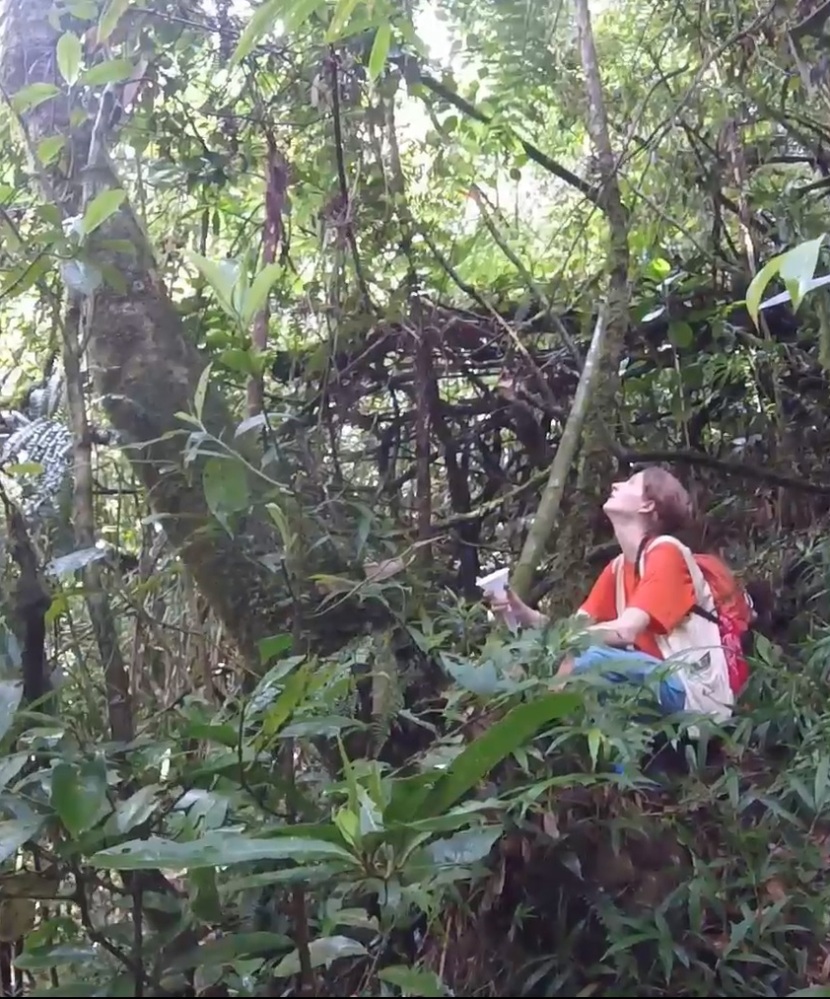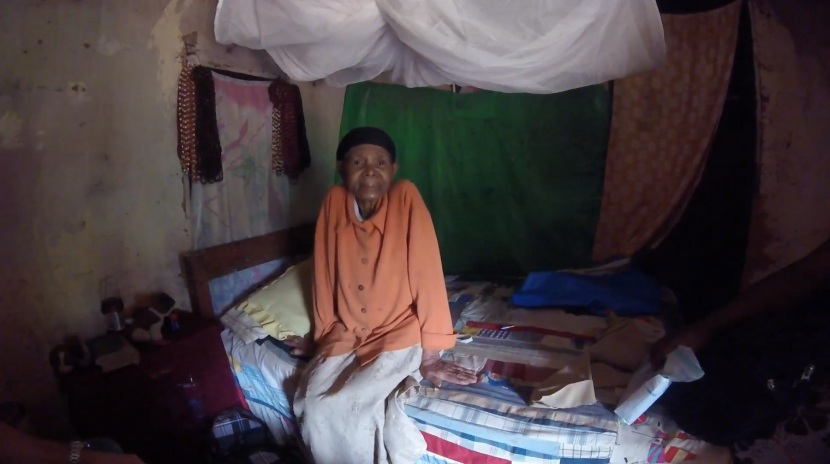Category: Research News

PhD Candidate and CVB Intern Track Lemurs for Research Samples
Stony Brook University PhD candidate Elise Lauterbur spent the day in the small unprotected rainforest of Ambatolahidimy on Jan. 8, 2016 to collect samples for her research on the three species of bamboo lemurs that are found in Madagascar.
Lauterbur has been studying bamboo lemurs under Patricia Wright, PhD, and Liliana Dávalos, PhD, for two years.

Elise Lauterbur observes a Golden Bamboo Lemur through her binoculars. Veronica Tuazon/CVB Rainforest News
“My research is to find out how bamboo lemurs tolerate the very large amounts of cyanide that’s naturally found in the bamboo they eat,” Lauterbur explained. “The Golden Bamboo Lemur and the Greater Bamboo Lemur have both been shown to ingest very large amounts of cyanide. In the case of the Golden Bamboo Lemur, it’s at least twelve times the amount of cyanide that would kill any other mammal of a similar size,” she continued. “We don’t know how they manage to survive this, and that’s what my research is to find out.”
In order to conduct this research, Lauterbur needs to collect urine samples from as many individual bamboo lemurs as possible. Analysis of the urine may reveal some biological processes that let the lemurs survive the consumption of cyanide.
To collect these samples, Lauterbur is accompanied into the forest by Centre ValBio research technicians Velo and Jean Claude to find the lemurs. The two guides have been observing the lemurs in this forest frequently, so they know where the groups are normally found. They can also track down the lemurs by looking for “lemur trash,” which is the part of the bamboo that the lemurs discard after eating. Once they locate the group of Golden Bamboo Lemurs sleeping in a tree, Lauterbur and her intern, Scott Kahl, sit down and wait for the lemurs to wake up.
After a few hours, the lemurs wake up, and the team follows them deeper into the forest and observes their behaviors. Kahl, a senior biology major at Stony Brook University, is looking for one behavior in particular: eating dirt. “It’s possible that they would be eating it [the dirt] for some kind of nutritional value for dealing with the cyanide in the bamboo,” Kahl explains.

Scott Kahl writes down his observations in a notebook. Veronica Tuazon/CVB Rainforest News
Lauterbur places herself underneath the lemur with a funnel and tube apparatus and waits to catch its urine. The sample has to be frozen as soon as possible so she can transport it back to her lab in the United States for analysis.
Lauterbur has collected 16 samples during the past two weeks, and she is staying at CVB until March.

CVB Intern Interviews Traditional Healers for Comparison Project
Senior biology student Joe Babinski of Stony Brook University met with three traditional healers from the area surrounding Centre ValBio on Jan. 7, 2016. Babinski is meeting with these healers to gather information for his internship project.
“My project is a comparison of the type of care that the Malagasy people are getting from the traditional healers and from the Western Health Team that operates out of the center,” Babinski explains, “it seems to me that depending on what type of illness they have, people will choose either the health team or a traditional healer.” “So far I have spoken with three or four traditional healers and asked them questions about the types of illness they see, the way they treat those illnesses, and the training that they’ve gotten,” he continued.
To gather information, Babinski sets out each morning with CVB Biodiversity Assistant Dina Heriala as his guide, and he attends arranged meetings with traditional healers. The first stop on this day’s journey was at a tiny house down the road from the town of Ranomafana to meet a midwife.

The midwife explains her methods while the village children watch. Veronica Tuazon/CVB Rainforest News
The 57-year-old woman sat on the floor of her home with a baby in her lap as the children of the village crowded at the door to catch a glimpse of the strange visitors. Through Babinski’s questions and Heriala’s translations, the midwife explained how she learned her skills through her grandmother, and named a few plants that she uses for her treatments.
After saying thank you and goodbye, Heriala lead Babinski to the home of another midwife who lives in a village directly above Ranomafana. This midwife explained that she has been practicing for 16 years, and that she works closely with the hospital in town. Babinski was elated to hear this information. “That’s exactly what I was hoping for,” he exclaimed after the interview, “some kind of relationship.”

The second midwife sits in her home listening for the translation of Babinski’s interview questions. Veronica Tuazon/CVB Rainforest News
The duo then descended back into town to meet a healer that specializes in burns and sore throats. At his small storefront in Ranomafana, he explained how he used ginger as a treatment for many ailments, and occasionally gave his patients Amoxicillin, which is a western antibiotic. With this new information, Babinski speculated that “traditional healers play an important cultural role, and fulfill a medical role when necessary, but those who are close enough [to the hospital] and can afford it prefer Western medicine.”

The burn healer stands at his counter in front of his medicinal plant products. Veronica Tuazon/CVB Rainforest News
Babinski still has to continue his research by joining the traveling medical team for their next expedition on Jan. 14, but so far he believes that “there seems to be three factors for choosing a healer: proximity, cost, and comfort.”

Joe Babinski interviewing a Malagasy traditional healer. Veronica Tuazon/CVB Rainforest News

CVB Intern Joins Reforestation Team to Conduct Research
Stony Brook University graduate student Carla Rodriguez is conducting her own research in reforestation during her internship at Centre ValBio. Rodriguez set out with Nicolas Rasolonjatovo, head of the 6-person Reforestation Team at CVB, on Jan. 6, 2016 to Morafeno Reforestation Site to begin plotting.
Rodriguez’s research as an Environmental Management major focuses on the growth in reforestation sites, which are forests that have been re-planted. She is also gathering data from fragmented forests, which are forests that have a significant amount of cleared land around them. At the end of her research, Rodriguez hopes that her data shows which species of trees survive the best during reforestation. She also plans to utilize her data, which involves some GPS mapping, to create a map of the reforestation sites for CVB.

Carla and Nicolas review the data table before collecting measurements. Veronica Tuazon/CVB Rainforest News
In Madagascar, the rainforests are always in danger. The majority of forests are destroyed by the people living nearby in order to create land for farming. Due to low quality soil and a lack of crop diversity, most agricultural families have to change locations every few years. This leads to even more destruction of the forest. Reforestation projects like CVB’s attempt to plant trees in areas where most of the forest has been cut down.
Morafeno Reforestation Site was planted in 2006 by school children who were learning about the environment. Although the trees are growing, Rodriguez’s project revealed that there is a high risk that all of the efforts in this site could be reversed due to destructive gold mining. Cavernous holes filled with water and quartz gravel appear all over the area of land where the trees are planted. These mines make it virtually impossible to plant trees. “They say they can find gold under those trees’ roots,” Rasolonjatovo explains, “so that’s why they get in the forest and dig a hole. So many trees fall down and die.”

Gold mining destroys the soil in potential reforestation sites. Veronica Tuazon/CVB Rainforest News
“If we give up, we can’t save anything,” Rasolonjatovo says. So despite the gold mining complications, the CVB Reforestation Team gets to work as Rodriguez finds the area of the entire site using a GPS. Then the team lays a measuring tape around some trees to create a 10 x 10 meter square called a “plot.” “We are going to take them [the plots] randomly, and we are going to be measuring all the trees within our plots,” explains Rodriguez, “my goal is to do five to ten plots a day.”
With help from team members Lucean and Alfred, Rodriguez collects the name and various measurements of each tree within the taped-out square and records the data in a table. She then proceeds to get the GPS coordinates of the plot for mapping purposes.
Rodriguez plans to gather data from about 60 plots throughout the duration of her three-week internship.
